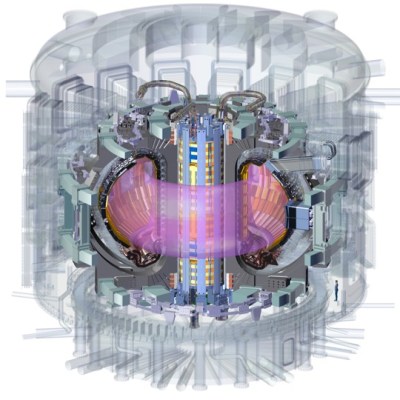What’s sixty feet (18.29 meters for the rest of the world) across and superconducting? The International Thermonuclear Experimental Reactor (ITER), and probably not much else.
The last parts of the central solenoid assembly have finally made their way to France from the United States, making both a milestone in the slow development of the world’s largest tokamak, and a reminder that despite the current international turmoil, we really can work together, even if we can’t agree on the units to do it in.

The central solenoid is 4.13 m across (that’s 13′ 7″ for burger enthusiasts) sits at the hole of the “doughnut” of the toroidal reactor. It is made up of six modules, each weighing 110 t (the weight of 44 Ford F-150 pickup trucks), stacked to a total height of 59 ft (that’s 18 m, if you prefer). Four of the six modules have been installed on-site, and the other two will be in place by the end of this year.
Each module was produced ITER by US, using superconducting material produced by ITER Japan, before being shipped for installation at the main ITER site in France — all to build a reactor based on a design from the Soviet Union. It doesn’t get much more international than this!
This magnet is, well, central to the functioning of a tokamak. Indeed, the presence of a central solenoid is one of the defining features of this type, compared to other toroidal rectors (like the earlier stellarator or spheromak). The central solenoid provides a strong magnetic field (in ITER, 13.1 T) that is key to confining and stabilizing the plasma in a tokamak, and inducing the 15 MA current that keeps the plasma going.
When it is eventually finished (now scheduled for initial operations in 2035) ITER aims to produce 500 MW of thermal power from 50 MW of input heating power via a deuterium-tritium fusion reaction. You can follow all news about the project here.
While a tokamak isn’t likely something you can hack together in your back yard, there’s always the Farnsworth Fusor, which you can even built to fit on your desk.
















The unit mangling in your article is just not fun, it’s dumb. No one measure weight in F-150 (since there are multiple version of the vehicle). So stick with a measurement system and keep it during the whole article. Ideally choose SI since it’s the only international system that’s used in international project like ITER, but no one would complain if you used empiric system using part of body to measure length.
I’m amazed you haven’t used BTU for the thermal power produced, I guess, using British unit is even worse offense than SI unit in the Empire?
Everyone knows the Toyota Corolla is the standard unit of weight.
You lot, messing with dumb measurements. Everyone knows the gold standard for weight is units of Hilux.
No, no, no, the Hilux is used as the standard for MTBF. It joins the Tesla, Henry and Farad as impractically large units that are universally preceded by prefixes like “micro” and “nano”.
And there is the universal use of mm. The cm is dead. I still cling to Angstrom and cgs.
It’s metric actually
Uuuhm, no. Elephants are. Asian or African Elephants? Woolly mammoths!
Metric or short ton?
“we really can work together, even if we can’t agree on the units to do it in.”
should’nt that be “..agree on the units to do it mm.”
“agree on the units to do it 25,4 mm”, to be correct.
Indeed. The proper format is “stacked to a height of 18m (x big macs)”. Swapping units partway through sentences unnecessary
“How big is this reactor?”
“Uhhh imagine a really big burger”
“What shape is it?”
“Um you know how sometimes they put a burger in a donut? That shape”
I’ll fix those ones, but the units stay as is or the whole comments section will make no sense.
I love the “Football pitch” size comparison. Weirdly enough, football pitches aren’t standardized, and the largest legal FIFA pitch (1,08ha) is 2⅔ as big as the smallest (0,405ha). Football pitches are generally used as 0,5 or 0,7 ha, with a standard UEFA field being bigger than that (7,140ha).
Oh yeah, to be clear, I’m talking about an association football (soccer) field here, because American Football fields are very precisely defined sizewise.
any idiot can use a unit converter if they care to. i dont know why people who write articles have to provide unit conversions for you. just use your own preferred unit, if the reader uses something different that’s their problem. me i use both. why? because some hardware store denizens cant handle change.
With the new generation coming up, it’ll all be measured in blocks and stacks,
We don’t even use BTUs in Britain any more
Amazing, an international reactor and you use Imperial as measuring system.
Stick to SI, this is hackaday, the audience here is mostly into engineering, don’t turn this into your average tabloid with clickbaity titles for below average-Joe’s level of science understanding.
They are clearly aware of as much, and told you so with the over the top units in the first paragraph. This wasn’t clickbait, it was just a bit of friendly trolling. I for one smiled. “For burger enthusiasts” was a new one for me, and I will be making use of it in the future.
Contrary to popular belief most Americans are perfectly capable of understanding metric units. Meters are just yards after all, soft drinks are sold in half gallon containers labeled “two liters”, and thanks to shrinkflation nothing else is sold in packages with a round number of units in either system. The only thing difference with the engineering crowd is we tend to care about more significant figures, and most of us have the conversion factors memorized.
Also contrary to popular belief, we are well aware that our units of measurement are wildly impractical (unless you need to divide something into thirds… or any other factor that isn’t 2, 5, or 10… then all those factors of 12 and 60 start looking a lot less random). :-P
So “unit translation” is NEVER about making something understandable. It is now an art form that we can use to poke at each other across oceans. It’s fun, and should never be allowed to die.
Keep using SI just to make these people grumpy
Funny. The Supercollider was going to have superconducting magnets sixty feet long. Some were even built. But it failed due to systemic dysfunction and never got completed.
I’m disappointed the units of “Olympic swimming pool” and “football field” weren’t used here though. They’re always good to add a bit of colonial flavour. :-)
And don’t forget about the standard imperial unit for data capacity: the Library of Congress.
Slashdot will not truly be dead until the last person (probably unknowingly) makes a reference to that one.
“Noooo you can’t use familiar human reference points to built your system of measurements for use by humans!! You have to define what a meter is during the French revolution by the length of a seconds pendulum (a pendulum with a half-period of one second) one century earlier, but this was rejected as it had been discovered that this length varied from place to place with local gravity.
Then you have to ret-con it as one ten-millionth of the shortest distance from the North Pole to the equator passing through Paris, assuming an Earth flattening of 1/334.
but that’s heckin imperialist, so you have to ret-con that as a resonance in the krypton-86 discharge lamp operating at the triple point of nitrogen (63.14 K, −210.01 °C), which was the state-of-the-art light source for interferometry in 1960, but it was soon to be superseded by a new invention: the laser.
So then you ret-con it as the frequency of the light from the methane-stabilised laser, which was found to be 88.376 181 627(50) THz. Somewhat inconveniently, the results gave two values for the speed of light, depending on which point on the krypton line was chosen to define the metre. This ambiguity was resolved in 1975, when the 15th CGPM approved a conventional value of the speed of light as exactly 299 792 458 m s−1.”
Or you could be like “A Yard is around the average length of a grown man’s pace.” and it’s almost exactly a meter, and obviously what the measurement was always meant to mimic.
Except it isn’t, you’ll be 10% off, and the yard was first defined when people were generally shorter.
The yard doesn’t come from the length of human stride, but from surveying ropes where you’d tie knots at approximately an arm’s length apart and use that to measure land. The first yard was “equal to the breadth of the Saxon’s chest”, then it was the length of Henry I’s arm from nose to the fingers, then they cut an arbitrary yardstick and made 40 copies of that to distribute around the kingdom. It’s merely luck or a coincidence of biology that it’s also approximately three feet or a pace.
Supercollider? I barely know her!
And then we built a supercollider.
So I wasn’t the only one to notice the clumsy measurements phrasing. Just use SI units and be done with it. I think a fair few HaD readers can cope with that. Disagree? Bite me.
Well, true, but HaD is written by writers, you see.
Brit here. Please use multiples of standard red London buses for length, height and weight to keep things clear. Or maybe even SI units with imperial units in parenthesis, or vice versa, but watch out for US and UK imperial units sometimes not being the same (eg gallons). No you can’t win.
We should really stop with the arbitrary units entirely and start using Planck units for everything. We’re going to get everyone converted to SI just in time to have this whole debate again with the first extra terrestrial civilization we make contact with.
While we are at it, can we PLEASE get a uniform system of prefixes based on factors of 60? No one in the galaxy is going to care how many fingers we have. Base 10 is going to make us the butt of jokes forever.
Why 60? Why not 11? Or 17 like the number of tentacles a ET civilization has?
Anyway, using ANY base is better than your system of not using a base at all. We, at least, all have 10 fingers, but not all of us have 8 inches in a foot or 32 foot in a hundred yard. Also 60 min in a 24 hour day is the dumbest division of time either.
we should be using base pi like all civilized species.
The unit mixing is kind of fun, in a way, even if it does make me cringe.
No comments on the use of tons without specifying whether it’s a US short ton, imperial long ton, or metric ton?
A metric ton is a tonne.
To be fair, they didn’t specify the model year or the trim level of the F-150’s either.
Standard convention (as far as I know, which is evidently not much!) is metric ton (tonne) gets the abbreviation t, the US short ton is tn, and long ton LT. So we’re talking (metric) tonnes in the article, hence the conversion to non-metric units.
Well, [Tyler] might just win the prize for “reader engagement” with this post. And that’s what pays the bills, after all, right?
You know, I did not expect this at all! I was just having a bit of fun. I’m a Canuck and the bouncing betwixt Imperial and Metric units is pretty normal here, in spite of it technically being a metric country.
As an American engineer I’m so used to operating in all the units that this stuff doesn’t even phase me.
Although I’ll admit that I do get annoyed by two coworkers where in a single meeting one will generally use Celsius while the other uses Fahrenheit and the two will simultaneously talk about a subject while using both units. That does get to be a bit tedious when one is talking about high temperature operation in Celsius and then the other lays into low temperature operation in Fahrenheit.
I’m occasionally in meetings where one party talks in kW (watt) and the other in kVA (Volt-Ampère). Yes, I know that for electric vehicle chargers and billing on power factor they are not the same, but for our line of work (how many kilometres kan a bus run, i.e. it’s /mileage/) they are the same thing.
And our software has a setting somewhere for kWh/h … which is kW, but in this context it is not, kWh/h being an average energy consunption of a sometines very peaky usage, and kW often being meant as a relatively flat current. We have hydrogen buses with a 2kW generator, a 30kWh battery, and the can not keep a 1,2kWh/h bus running.
That must be a very very small or very very slow bus. A typical passenger sedan will burn 10 kWh/h.
A more useful metric would be kWh/km, which for a typical sedan is around 0.2-0.3 kWh/km, so for 1.2 kWh/h it would be doing about 5 km/h. A bus can easily take 10x as much, so it would be a really slow bus indeed.
Sorry, I was tired when writing this. Our software does have a setting for kWh/h, which is for the standby power usage (computers and HVAC) when the bus is at a standstill.
The driving power usage is given in kWh/km (which I meant with the 1,2kWh/km figure)…
The previous version had a column for power usage while driving labelled “kWh/km/mile” – there is a general setting to use metric or imperial in the software, but this one column header wasn’t updated to reflect that in that version. I’m not sure how to simplify that, as (kWh/km)/mile which would give a changing number based on the actual distance measured, or as kWh/(km/mile) which would be kWh/1,6 …
This is the reason that binary star systems exist. One natural, the other made by the natives ;)
One unit not mentioned for British readers was velocity measured by an “unladen swallow”. However, all joking aside, mixing measurements have had serious consequences. Spacecraft have flown by planets they were supposed to land on or shut off their engines thinking they had landed only to crash from meters above the surface. There is even the remarkable story of the “Gimli Glider”, passenger jet flight 174, which was under-fueled due to the difference in measurements and whose pilots heroically glided it to a safe landing. I have seen articles and documentation where the numbers for feet and meters were transposed leading to a very confusing read. So mixing measurements to cater to both audiences can cause trouble.
And no unit discussion is complete with mentioning the Smoot.
You know, I’m not sure we’ve covered the happenings at MIT’s fusion lab recently. If we do, I will be sure to point out that their SPARC reactor will be 1.09 Smoots across.
The units seem to originally be in metric and have inflated. Also its the height that is 18m with support structure (that has been approximated to 60ft and then mistakenly converted back). the diameter is 4.13m.
See the original detail here which correlates with the ITER announcement.
https://www.ga.com/general-atomics-fabricates-the-worlds-largest-superconducting-electromagnet#:~:text=Central%20Solenoid%20technical%20information%3A%20Height%3A,Operating%20voltage%3A%2014%20kilovolts
A nitpick: the four modules are assembled, in the room next to the reactor. Once the six of them are assembled they will be moved and installed in the centre of the tokamak (although I think they need to finish the rest of the chamber first).
Source: I was there earlier today.
This comment is why HaD is the best
what will we have first? fusion power, or a usable beta of reactos?
ReactOS for sure. It’s made some good headway in the last few years. However, I would caution that compatibility is likely to be more like Win7 than Win11.
2070 is the earliest that the fusion power will be an option.
13.1 Teslas doesn’t seem like nearly enough for full confinement but I hope it’s enough for them to learn the root cause of the disturbances.
It is, if you use 49 foot tie bars. Apparently.
There are other magnets, the central solenoid is there to induce a current in the plasma and make it controllable.